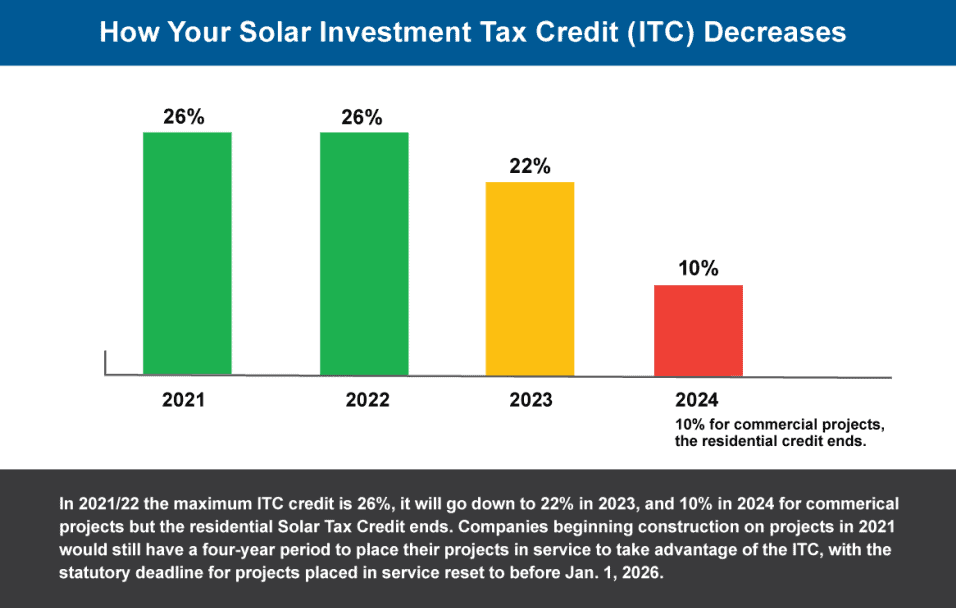The solar tax credit is a federal incentive the Government offers to commercial building owners who install solar panels on their property through December 2034. The federal solar tax credit in 2023 is worth 30% of your solar installation costs and will be available from 2022 until 2032. This type of credit allows property owners to recover a fixed percentage of the solar panel system’s cost and a lower cost per kW of consumption, making it attractive to taxpayers.
What Is The Solar Tax Credit?
The solar tax credit offers a dollar-for-dollar reduction in federal tax liability.
Internal Revenue Code (IRC) Sections 48(a)(3)(i) and 48(a)(3)(ii) grant businesses a tax credit for solar equipment as part of the energy credit. The energy credit, in turn, contributes to the investment tax credit. Finally, the investment tax credit comprises part of the general business credit.

The general business credit can only offset tax liability. However, any unused portion can go against tax from the prior year and up to twenty future years.
The amount of the solar tax credit equals a percentage of the cost of eligible property—called solar energy property—placed in service during the year. This percentage varies according to the year construction began:
- 30% in 2019 or earlier.
- 26% in 2020-2022.
- 22% in 2023.
- 10% in 2024 or later—0% for fiber-optic solar energy property.
The credit automatically drops to 10% if your business doesn’t start using the solar equipment before January 1, 2026.
Understanding Solar Tax Credit For Your Business
There are two tax credits available for businesses and other entities like nonprofits and local and tribal governments that purchase solar energy systems
- The investment tax credit (ITC) is a tax credit that reduces the federal income tax liability for a percentage of the cost of a solar system that is installed during the tax year.
- The production tax credit (PTC) is a per kilowatt-hour (kWh) tax credit for electricity generated by solar and other qualifying technologies for the first 10 years of a system’s operation. It reduces the federal income tax liability and is adjusted annually for inflation.
However, depending on the IRS’s future guidance, project owners may be able to claim separate credits for co-located systems like solar and storage. In general, project owners cannot claim PT and the ITC for the same property.
Other storage technologies and renewable energy forms are also eligible for the ITC. If they meet the labor specifications set forth by the Treasury Department or are smaller than 1 megawatt (MW), solar systems that go into service in 2022 or later and begin construction before 2030 are eligible for getting 2.6 PTC and 30% ITC.
How Does The ITC Work For Businesses?
Importantly, the ITC is a tax credit not a tax deduction. Here’s what that means in practice, with an example $100,000 solar panel system for a business with $100,000 in taxable income to keep the math simple:
If you have earnings of $100,000 on a 37 percent tax rate, then you’ll pay $37,000 in taxes. Both MACRS and bonus depreciation reduce your taxable earnings, meaning for a $100,000 solar project, bonus depreciation will reduce your taxable earnings by $87,000. So instead of paying taxes on $100,000, you’ll pay taxes on $13,000, meaning you’d owe $4,810 in taxes instead of $37,000 pre-solar. In that way, bonus depreciation provides a benefit while helping you save on what you owe in taxes.
The ITC, on the other hand, is a direct credit on your taxes: instead of reducing your taxable earnings, the ITC just is a credit towards what you owe. So with the same example above, and at the current 30 percent rate, the ITC would reduce how much you owe in taxes by $30,000, dropping what you owe from $37,000 to $7,000.
And the cool thing about it is that, as a business, you can take advantage of both the ITC and bonus depreciation, leading to pretty significant savings from solar.
How Do I Claim The ITC And PTC?
To claim solar as a business expense, you need to report the year your business started using the solar-powered property on lines 12b, 12c, and 12d. It depends on the year during which construction started.
To claim the ITC, a taxpayer must complete and attach IRS Form 3468 to their tax return. Instructions for completing the form are available at http://www.irs.gov/pub/irs-pdf/i3468.pdf (“Instructions for Form 3468,” IRS).
After being determined on Form 3468, the investment credit is subsequently entered on Form 3800. The company credit is calculated on Form 3800, while it appears on Schedule 3 (Form 1040) for individuals.
Be careful not to mix up the residential and commercial solar tax credits when referring to the solar tax credit. Keep in mind that the home credits have the same but different rules.
To claim the PTC, a taxpayer must complete and attach IRS Form 8962 to their tax return. Instructions for completing the form are available at http://www.irs.gov/pub/irs-pdf/i8962.pdf (“Instructions for Form 8962,” IRS).
However, tax savings from the solar tax credit for businesses are substantial. After 2022, the credit percentage reduction, you can maximize your savings for your business by planning solar panel installation.
Eligibility Criteria
- This benefit can only be claimed once, in the tax year, your solar panel system is installed.
- You can claim the Solar Investment Tax Credit if you installed them from 2006-2034.
- You can only claim it for the original installation of the system, not for reuse or upgrade.
- If you use your system for a community project and it does not exceed the electricity consumption standard.
- It only applies to taxpayers who own the system, not those who lease the property.
Tips To Maximize Their Solar Tax Credits
- The ideal time to purchase a solar panel system is in 2023 to take advantage of the maximum 30% ITC amount and be able to deduct it from your tax return.
- We suggest you purchase all the necessary storage components based on your property’s energy demands to add to your total cost deduction.
- Before purchasing your solar panel system, trust a certified company. Otherwise, you will not be able to apply for the benefit.
What Projects Are Eligible For The ITC Or PTC?
To be eligible for the business ITC or PTC, the solar system must be:
- Located in the United States or U.S. territories
- Use new and limited previously used equipment
- Not leased to a tax-exempt entity (e.g., a school), though tax exempt entities are eligible to receive the ITC themselves in the form of a direct payment.
Since most business owners can’t use both credits, it’s important to choose a credit based on which one is likely to give you the biggest tax credit. Generally, businesses in sunny areas should opt for the PTC, as it’s a production-based credit. If your business operates in Phoenix, Albuquerque or another sun-drenched city, you may qualify for a much bigger credit with the PTC than you would with the ITC.
Conversely, businesses in Seattle, Miami, New Orleans, and other cities known for frequent precipitation are likely to make out better if they choose the ITC, which isn’t production-dependent. If you choose the ITC, you may qualify for the maximum credit even if you don’t produce as much solar energy as anticipated. The ITC is also a good choice for projects with high installation costs.
Conclusion
The advantages of the Commercial Solar Tax Credit for businesses; not only does it allow you to switch to more stable, sustainable, and efficient energy sources. It protects your equipment from events such as power failures or outages and allows your business to run smoothly without leaving a footprint on the environment. It also allows them to obtain a decrease in their income tax return and is a more economical option in the long term since installing solar panels reduces the consumption of Kw per month.

Finally, going solar gives business owners the opportunity to future-proof their operations. With the federal government offering so many incentives to reduce energy usage, it’s likely that we’ll be less reliant on fossil fuels in the near future. If you go solar now, you’ll be well-positioned to adapt to upcoming changes in the energy market.



Recent Comments